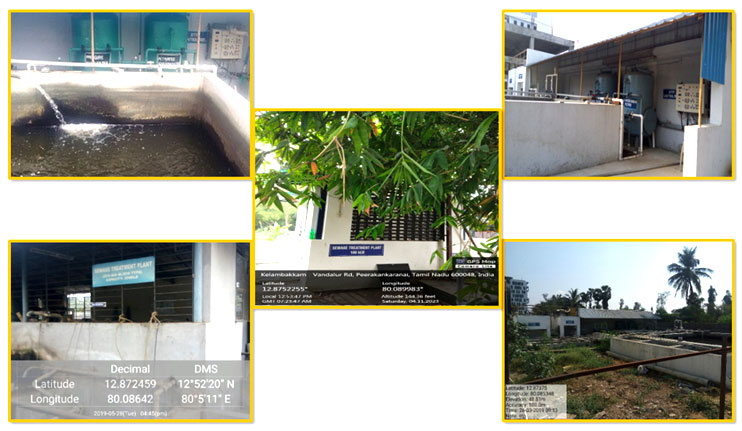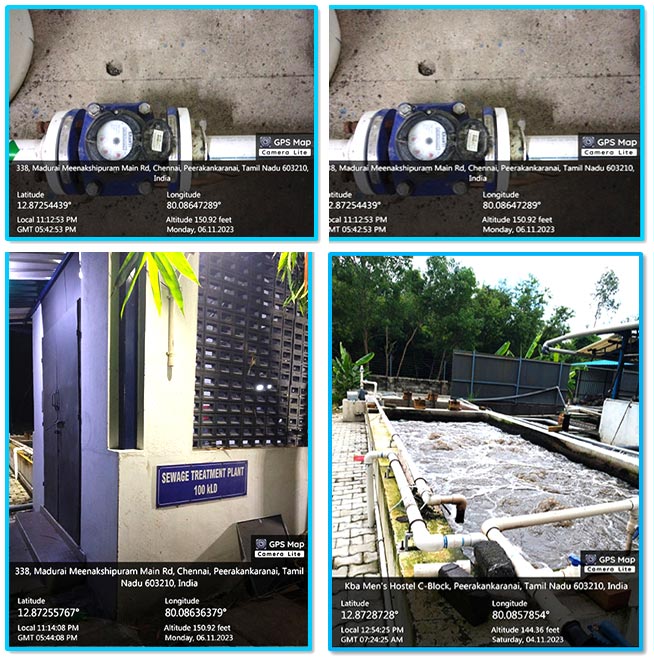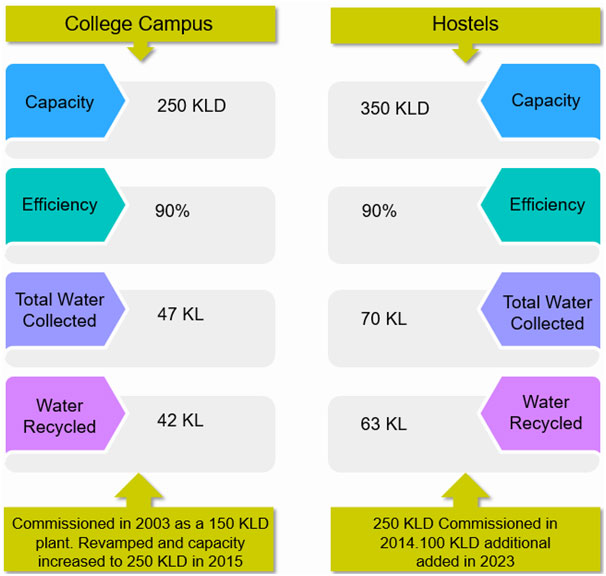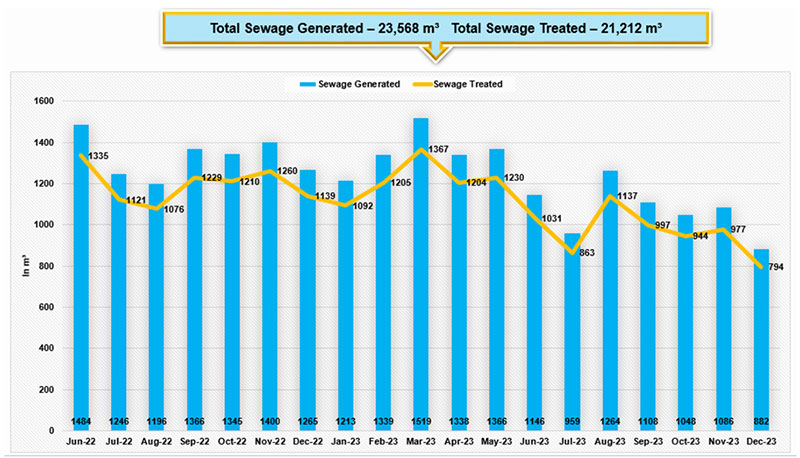Crescent Sustainability Initiatives
CLEAN WATER AND SANITATION (SDG 6)
B.S. Abdur Rahman Crescent Institute of Science and Technology exemplifies this commitment through its comprehensive wastewater treatment and liquid waste management strategies, ensuring the sustainable use of water within its campus.
The university has established effective measures for treating wastewater generated on its premises, ensuring that the treated water is reused efficiently. The estate office has implemented sustainable sewage treatment plants designed to handle the university’s wastewater effectively. In 2022, an additional sewage treatment plant (STP) with a capacity of 100 KLD was commissioned at the KBA Men’s Hostel, enhancing the existing sewage treatment plants.
Infrastructure Overview
Currently, the university operates two sewage treatment plants, each with a capacity of 250 KLD—one dedicated to the Men’s Hostel and the other serving the institute campus. This infrastructure is critical for managing sewage, which typically contains a mix of organic, inorganic, and suspended solids. The treatment process is structured to remove these pollutants, allowing for effective reuse of the treated water.

Figure VI (3.1) – 1: 250 KLD and 100 KLD – STP – Geo-tagged photographs
Treatment Process
The treatment system comprises several stages, beginning with preliminary treatment to eliminate floating debris and grit. Bar screens filter out plastics and other floating materials, while grit chambers remove sand and silt. The primary sedimentation tank further aids in the removal of suspended solids. Following this, the secondary treatment process employs a biological treatment system to remove organic content from the wastewater.
Eco-bio blocks are incorporated to enhance the efficiency of biological treatment. These blocks facilitate the attachment of beneficial bacteria, improving the removal of organic matter and enabling the system to handle fluctuations in organic loading. The treatment process operates on the principle of an attached growth aerobic system, followed by sand and carbon filters that ensure any residual organics are adequately adsorbed before the treated water is stored in a collection.

Figure VI (3.1) – 2: Geo-tagged photographs showing two STPs of capacity 250 KLD and 100 KLD
Maintenance and Monitoring
Regular maintenance of the sewage treatment plants is a priority, with periodic checks on all pumps and valves to ensure optimal functioning. The treated water is primarily utilized for landscaping and toilet flushing, significantly reducing the university’s dependence on fresh water from wells for gardening purposes.
To ensure the effectiveness of the treatment systems, the physical, chemical, and biological characteristics of the treated water are routinely tested. Key parameters such as pH, solids, Chemical Oxygen Demand (COD), biochemical oxygen demand (BOD), nitrates, and chlorides are monitored to maintain water quality suitable for reuse.

Figure VI (3.1) – 3: Details of Wastewater Recycled
DESCRIPTION OF THE DIAGRAM (Figure VI – 4):
1. College Campus
- Capacity: The sewage treatment plant has a capacity of 250 kiloliters per day (KLD).
- Efficiency: The system operates at an efficiency rate of 90%, indicating effective treatment and utilization of water resources.
- Total Water Collected: A total of 47 kiloliters (KL)of water is collected for treatment.
- Water Recycled: Out of the collected water, 42 KLis recycled, showcasing a high rate of resource recovery.
- Commissioning Information: The plant was originally commissioned in 2003as a 150 KLD facility and underwent renovations in 2015, increasing its capacity to 250 KLD.
2. Hostels
- Capacity: The hostel’s sewage treatment facility has a capacity of 350 KLD, which provides sufficient treatment for the needs of the hostel residents.
- Efficiency: Similar to the campus, this system also operates at 90% efficiency.
- Total Water Collected: The hostel collects a total of 70 KLof water for treatment.
- Water Recycled: From the collected water, 63 KLis recycled, indicating a strong commitment to sustainable water use.
- Commissioning Information: The hostel’s sewage treatment plant was commissioned in 2014as a 250 KLD facility, with an additional 100 KLD added in 2023 to enhance capacity and meet growing demand.
Overall, the diagram illustrates the effective water management systems in place at the College Campus and Hostels of BSACIST. Both systems demonstrate efficient operation, significant water recycling, and a commitment to enhancing infrastructure over time. The comparisons highlight how the university prioritizes sustainable practices in water management to support its growing community.
Table VI (3.1) – 1: Recycled Water Data for the period 2022-23
Sl. No. | Month / Year | No.of Loads | Quantity of Lorry Water before treatment m³ | Lorry Water after treatment (90%) m³ | Well Water before treatment (100%) m³ | Well Water after treatment (90% out of 5000) m³ | Total Treated Water m³ | Sewage Generated 80% m³ | Sewage Treatment 90% m³ |
1 | Jun-22 | 1792 | 1792 m³ | 1,613 | 269 | 242 | 1,855 | 1,484 | 1,335 |
2 | Jul-22 | 1459 | 1459 m³ | 1,313 | 271 | 244 | 1,557 | 1,246 | 1,121 |
3 | Aug-22 | 1395 | 1395 m³ | 1,256 | 266 | 239 | 1,495 | 1,196 | 1,076 |
4 | Sep-22 | 1646 | 1646 m³ | 1,481 | 251 | 226 | 1,707 | 1,366 | 1,229 |
5 | Oct-22 | 1590 | 1590 m³ | 1,431 | 278 | 250 | 1,681 | 1,345 | 1,210 |
6 | Nov-22 | 1685 | 1685 m³ | 1,517 | 259 | 233 | 1,750 | 1,400 | 1,260 |
7 | Dec-22 | 1507 | 1507 m³ | 1,356 | 250 | 225 | 1,581 | 1,265 | 1,139 |
8 | Jan-23 | 1422 | 1422 m³ | 1,280 | 263 | 237 | 1,517 | 1,213 | 1,092 |
9 | Feb-23 | 1606 | 1606 m³ | 1,445 | 253 | 228 | 1,673 | 1,339 | 1,205 |
10 | Mar-23 | 1855 | 1855 m³ | 1,670 | 254 | 229 | 1,899 | 1,519 | 1,367 |
11 | Apr-23 | 1586 | 1586 m³ | 1,427 | 272 | 245 | 1,672 | 1,338 | 1,204 |
12 | May-23 | 1623 | 1623 m³ | 1,461 | 274 | 247 | 1,708 | 1,366 | 1,230 |
13 | Jun-23 | 1324 | 1324 m³ | 1,192 | 268 | 241 | 1,433 | 1,146 | 1,031 |
14 | Jul-23 | 1057 | 1057 m³ | 951 | 276 | 248 | 1,199 | 959 | 863 |
15 | Aug-23 | 1503 | 1503 m³ | 1,353 | 252 | 227 | 1,580 | 1,264 | 1,137 |
16 | Sep-23 | 1274 | 1274 m³ | 1,147 | 264 | 238 | 1,385 | 1,108 | 997 |
17 | Oct-23 | 1194 | 1194 m³ | 1,075 | 262 | 236 | 1,311 | 1,048 | 944 |
18 | Nov-23 | 1247 | 1247 m³ | 1,122 | 261 | 235 | 1,357 | 1,086 | 977 |
19 | Dec-23 | 969 | 969 m³ | 872 | 256 | 230 | 1,102 | 882 | 794 |
Total | 27,734 | 27,734 m³ | 24,961 | 5,000 | 4,500 | 29,461 | 23568 | 21212 | |

Figure VI (3.1) – 4: Sewage Treated Water for the year 2022-23 in m³
Water Treatment and Sewage Management Report
The following table summarizes the monthly water treatment and sewage management data from June 2022 to December 2023. It documents the quantities of lorry and well water used, the treatment processes undertaken, and the associated sewage generated and treated.
Overview of Water Sources and Treatment Process
- Lorry Water Treatment: Each month, lorry water was collected in various quantities, and after treatment, 90% efficiency was achieved. The data shows a monthly range of lorry water treated, with figures fluctuating from 951 m³ to 1,670 m³.
- Well Water Treatment: Collected well water, which was fully utilized initially (100%), underwent a similar treatment process at 90% efficiency. This process yielded an average collection close to 242 m³ and peaked at 278 m³ during specific months.
- Total Treated Water: The combined total of treated water from both sources shows a consistent monthly output, indicating effective resource management.
Monthly Water and Sewage Management
- Monthly data from June 2022 to December 2023 showed significant variations, with total water collected each month reflecting operational demands and treatment capacities.
- For instance, June 2022 recorded a collection of 1,792 m³ of lorry water, generating 1,484 m³ of treated water and 1,335 m³ of sewage produced. Over the period, the highest recorded sewage generation was 1,899 m³ in March 2023.
- The total treated water from all sources across the reporting period was 29,461 m³, while the total sewage generated reached 23,568 m³. Furthermore, the total sewage treated was 21,212 m³, representing a significant efficiency in sewage management.
The data reflects a proactive approach to managing both water resources and sewage treatment within the facility. The implementation of efficient treatment processes has led to substantial recycling of water, aligning with sustainability goals. Continuous monitoring and analysis of monthly figures ensure that the facility can make informed decisions regarding water usage and treatment efficacy, ultimately contributing to responsible environmental stewardship.
Water Management and Reuse Policy
Issue: 04; Revised on 2023
| Policy Created on | July 2009 |
| 1st Revision amended on | IQAC Meeting held on 27th October 2017 |
| 2nd Revision amended on | IQAC Meeting held on 31st March 2021 |
| 3rd Revision amended on | IQAC Meeting held on 16th June 2023 |
6.1 STATEMENT OF POLICY
The B.S. Abdur Rahman Crescent Institute of Science and Technology is committed to achieving the following objectives in alignment with Sustainable Development Goal 6 (SDG 6) – Clean Water and Sanitation:
- a) Ensure universal and equitable access to safe and affordable drinking water for all stakeholders.
- b) Provide adequate and equitable sanitation and hygiene for all, with special attention to the needs of women, girls, and vulnerable groups.
- c) Improve water quality by reducing pollution, eliminating dumping, and minimizing the release of hazardous chemicals and materials.
- d) Halve the proportion of untreated wastewater and substantially increase recycling and safe reuse globally.
- e) Substantially increase water-use efficiency across all sectors and ensure sustainable withdrawals and freshwater supply to address water scarcity.
- f) Implement integrated water resources management at all levels, including transboundary cooperation as appropriate.
- g) Protect and restore water-related ecosystems, including mountains, forests, wetlands, rivers, aquifers, and lakes.
- h) Expand international cooperation and capacity-building support to developing countries in water- and sanitation-related activities and programs.
- i) Support and strengthen the participation of local communities in improving water and sanitation management.
6.2 REASON FOR THIS POLICY
The policy aims to provide all stakeholders with adequate water supply, sanitation, and hygiene. It emphasises maximising the collection and treatment of sewage generated and the reuse of treated wastewater sustainably, thereby reducing dependency on freshwater resources. The policy promotes treating wastewater as an economic resource.
6.3 RESPONSIBILITIES
6.3.1 Policy Principles
- a) The campus shall provide adequate water supply and maximize water reuse by adhering to the following principles:
- Equitable access to safe and affordable drinking water for all stakeholders.
- Access to adequate sanitation and hygiene, ending open defecation, with special attention to vulnerable groups.
- Calculation of water usage per person (students, staff, and faculty) annually.
- Improving water quality by reducing pollution and increasing recycling and safe reuse.
- Utilization of recycled/treated wastewater for beneficial purposes, such as irrigation and toilet flushing.
- Implementation of integrated water resources management at all levels.
- Protection and restoration of water-related ecosystems on campus.
- Expansion of rainwater harvesting initiatives.
- Collaboration with government, NGOs, and industries in water-related activities.
- Support for student and staff participation in water management.
6.4.1 Water Reuse Policy Objectives
- Establish a comprehensive policy to maximize water reuse across the university.
- Ensure that all new buildings adhere to water-conscious building standards that facilitate water reuse.
- Implement systems for tracking and measuring water consumption and reuse.
6.4.2 Water Reuse
- Water Reuse Policy: maximise water reuse across the university.
- Water Reuse Measurement: Measure water reuse across the university.
6.5 DISSEMINATION OF POLICY
- a) Display signage promoting water use efficiency across the campus.
- b) Conduct awareness programs at regular intervals to increase water-use efficiency.
- c) Post the policy on the Institute’s website and update it as necessary.
6.6 ENFORCEMENT OF POLICY
- a) The Director (Planning & Development) and Deputy Director monitor compliance and address breaches.
- b) Awareness of the policy among students, staff, and visitors is essential.
- c) Breaches may lead to disciplinary action as per the Institute’s code of conduct.
REGISTRAR


